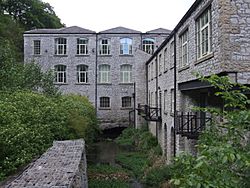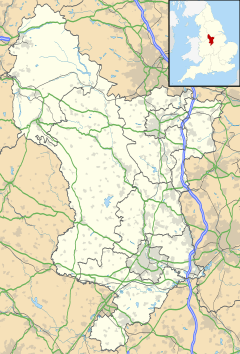Litton Mill facts for kids
 |
|
| Cotton | |
|---|---|
| Water spinning mill | |
| Client | Ellis Needham and Thomas Frith |
| Further ownership |
|
| Coordinates | 53°15′14″N 1°45′43″W / 53.254°N 1.762°W |
| Construction | |
| Built | 1782 |
| Demolished | 1874 (New mill built) |
Litton Mill is an old factory in Millers Dale, near Tideswell in Derbyshire, England. It was a textile mill, meaning it made cloth. This mill became well-known during the Industrial Revolution because of its difficult working conditions, especially for young workers. One famous story is from Robert Blincoe, a young apprentice who worked there.
Contents
Litton Mill: A Historic Cotton Factory
Litton Mill was a cotton factory that used water power. It was built in a beautiful but isolated valley. The mill is an important part of the history of the Industrial Revolution in England.
How Litton Mill Started
Litton Mill was built in 1782 by two farmers, Ellis Needham and Thomas Frith. They used the water from the River Wye to power their machines. These machines were called water frames, invented by Richard Arkwright.
The location of the mill was a big problem. It was very hard to transport raw materials and finished goods. Also, it was difficult to find people to work there. Other early factory owners could find workers from nearby towns. But the area around Litton had mostly farmers who did not want to work in factories.
Early Struggles and Challenges
By 1786, the mill was not making much money and was put up for sale. But no one wanted to buy it. Needham and Frith kept trying to make it work. Needham lost most of his money. Frith left the business in 1799.
Because they could not find local workers, Needham and Frith used a system called "parish apprentices." This was based on the Poor Law Act of 1601. Under this law, local churches or towns could send poor children to work for employers. The employer would promise to care for and train the child. Sometimes this helped the children, but often it was a way for employers to get cheap labor. It also helped towns avoid having to support poor children.
In the early 1800s, the cotton industry faced tough times. The number of workers at Litton Mill was cut in half. There was also a serious fire. In 1811, the waterwheel broke down for a whole month. By 1815, Needham had lost everything and was declared bankrupt. He became very poor by 1828. Frith did a bit better, working on his farm and running a small mill nearby.
New Owners and Changes
For a while, the Newtons, who owned Cressbrook Mill, operated Litton Mill. But in 1874, another fire destroyed the mill. Not much of the original building is left today. The factory that replaced it now makes nylon yarn for hosiery (socks and stockings).
In 1893, Mr. Matthew Dickie bought Litton Mill. He was a mill owner from Stockport. Mr. Dickie brought several families from Stockport to work at Litton Mill. He also created the Litton & Cressbrook Mills Company and took over Cressbrook Mill.
To make it easier to get between the two mills, Mr. Dickie's company built a road along the river. Visitors could use this road, but they had to pay a small fee. This money went to local hospitals. This new road also made the journey to Monsal Dale shorter. Litton Mill was sold to a group of investors in 1934.
Matthew Dickie had a large house called Ravenstor built for his family. In 1937, this house and about 64 acres (260,000 m²) of land were given to the National Trust. This land included a mile-long stretch of the River Wye and Tideswell Dale. Today, Ravenstor is leased to the Youth Hostel Association and is open all year round.


